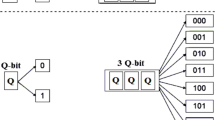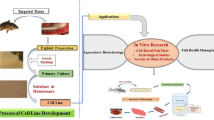Abstract
Chromosome constitution was investigated in adult tetraploid Pacific oyster produced by blocking the first polar body of triploid eggs which were fertilized with haploid sperms. A high incidence of aneuploid and heteroploid mosaics were found among the offspring. Of 20 individuals identified, only 9 (45%) were eutetraploid which contained 40 chromosomes; 2 (10%) were aneuploid (hypotetraploid), which contained 39 and 38 chromosomes, respectively; and 9 (45%) were heteroploid mosaics. One mosaic was consisted of cells containing 40 and 39 chromosomes, respectiovely (1:1 in cell number), while the other 8 were consisted of cells containing chromosomes varying between tetraploid and triploid. It was also interesting to note that 3 mosaics even contained some diploid cells with 20 chromosomes. A certain number of cells of 2 tetraploids and 8 mosaics spread with 32–37 well-scattered and some clumped chromosomes at metaphase. The percentage of aneuploid cells with chromosomes varying between triploid and tetraploid correlated significantly with that of heteroploid mosaics cells with clumping chromosomes (P<0.05). Our findings suggested that reversion existed in both tetraploid and triploid oyster and chromosome clumping may underline the chromosome elimination in tetraploid oyster. It seems that the reversing cells, at least some of them, continuously eliminate their chromosomes until the most stable diploid state is established.
Similar content being viewed by others
References
Allen Jr., S. K., 1983. Flow cytometry: Assaying experimental polyploid fish and shellfish. Aquaculture, 33: 317–328.
Allen Jr., S. K., 1988. Triploid oysters ensure year-round supply. Oceanus, 31: 58–63.
Allen Jr., S. K., and Bushek, D., 1992. Large scale production of triploid Crassostrea virginica (Gmelin) using ‘stripped’ gametes. Aquaculture, 103: 241–251.
Allen Jr., S. K., Downing, S. L., and Chew, K. K., 1989. Hatchery Manual for Producing Triploid Oyster. University of Washington Press, Seattle, Washington, 1–27.
Allen Jr., S. K., Guo, X., Burreson, G., and Mann, R., 1996. Heteroploid mosaics and reversion among triploid oysters, Crassostrea gigas: Fact or artifact. Journal of Shellfish Research, 15: 514–522.
Allendorf, F. W., and Thorgaard, G. H., 1984. Tetraploidy and the evolution of salmonid fishes. In: Evolutionary Genetics of Fishes. Turner, B. J., ed., Plenum, New York, 1–53.
Andreassen, P. R., Martineau, S. N., and Margolis, R. L., 1996. Chemical induction of mitotic checkpoint override in mammalian cells results in aneuploidy following a transient tetraploid state. Mutegenesis Research, 372: 181–194, DOI: 10.1016/S0027-5107(96)00138-8.
Arai, K., 2001. Genetic improvement of aquaculture finfish species by chromosome manipulation techniques in Japan. Aquaculture, 197: 205–228.
Darlington, C. D., 1953. Polyploidy in animals. Nature, 171: 191–194.
Davisson, M. T., Wright, J. E., and Atherton, L. M., 1972. Centric fusion and trisomy for the LDH-B locus in brood trout, Salvelinus fontinalis. Science, 178: 992–994.
de Met, J. M. J., 1971. Reversible tetraploidy as an evolutionary mechanism. Evolution, 25: 545–548.
de Met, J. M. J., and Harlan, J. R., 1970. Apomixis, polyploidy and speciation in Dichanthium. Evolution, 24: 270–277.
Ferris, S. D., 1984. Tetraploidy and evolution of the catostomid fishes. In: Evolutionary Genetics of Fishes. Turner, B. J., ed., Plenum, New York, 55–93.
Giareti, W., 1994. A model of DNA aeuploidization and evolution in colorectal cancer. Laboratory Investigation, 71: 904–910.
Gong, N., Yang, H., Zhang, G., Landau, B. J., and Guo, X., 2004. Chromosome inheritance in triploid Pacific oyster Crassostrea gigas Thunberg. Heredity, 93(5): 408–415.
Guo, X., and Allen Jr., S. K., 1994. Viable tetraploids in the Pacific oyster (Crassostrea gigas Thunberg) produced by inhibiting polar body I in eggs from triploids. Molecular Marine Biology and Biotechnology, 3: 42–50.
Guo, X., and Allen Jr., S. K., 1997. Sex and meiosis in autotetraploid Pacific oyster, Crassostrea gigas (Thunberg). Genome, 40: 397405.
Guo, X., Cooper, K., Hershberger, W. K., and Chew, K. K., 1992a. Genetic consequences of blocking polar body I with cytochalasin B in fertilized eggs of the Pacific oyster, Crassostrea gigas: I. Ploidy of resultant embryos. Biological Bulletin, 183: 381–386.
Guo, X., Cooper, K., Hershberger, W. K., and Chew, K. K., 1992b. Genetic consequences of blocking polar body I with cytochalasin B in fertilized eggs of the Pacific oyster, Crassostrea gigas: II. Segregation of chromosomes. Biological Bulletin, 183: 387–393.
Guo, X., Debrosse, G. A., and Allen Jr., S. K., 1996. All triploid Pacific oyster (Crassostrea gigas Thunberg) produced by mating tetraploids and diploids. Aquaculture, 142: 149–161.
Guo, X., Wang, Y., Xu, Z., and Yang, H., 2009. Chromosome set manipulation in shellfish. In: New Technologies in Aquaculture: Improving Production Efficiency, Quality and Environ mental Management. Burnell, G., and Allan, G., eds., Woodhead Publishing, 165–195.
Johnannes, A., Breeuwer, J., and Werren, J. H., 1990. Microorganisms associated with chromosome destruction and reproductive isolation between two insect species. Nature, 346: 558–560.
Kimber, G., and Riley, R., 1963. Haploid angiosperms. Botanical Review, 29: 480–531.
Komaru, A., Matsuda, H., Yamakawa, T., and Wada, K. T., 1990. Chromosome-behavior of meiosis-inhibited eggs with cytochalasin B in Japanese pearl oyster. Nippon Suisan Gakkaishi, 569: 1419–1422.
Levine, D. S., Sanchez, C. A., Rabinovitch, P. S., and Reid, B. J., 1991. Formation of the tetraploid intermediate is associated with the development of cells with more than four centrioles in the elastase-simian virus 40 tumor antigen transgenic mouse model of pancreatic cancer. Medical Science, 88: 6427–6431.
Lewis, W. H., Oliver, R. L., and Luikart, T. J., 1971. Multiple genotypes in individuals of Claytonia virginica. Science, 172: 564–565.
Li, Y. J., Yu, Z., Zhang, M. Z., Qian, C., Abe, S., and Arai, K., 2011. The origin of natural tetraploid loach Misgurnus anguillicaudatus (Teleostei: Cobitidae) inferred from meiotic chromosome configurations. Genetica, 139: 805–811, DOI: 10.1007/s10709-011-9585-x.
Liu, S., 2010. Distant hybridization leads to different ploidy fishes. Science in China Life Science, 53(4): 416–25, DOI: 10.1007/s11427-010-0057-9.
Longo, F. J., 1972. The effects of cytochalasin B on the events of fertilization in the surf clam, Spisula solidissima I polar body formation. Journal of Experimental Zoology, 182: 321–344.
Longo, F. J., Mathews, L., and Hedgecock, D., 1993. Morphogenesis of maternal and paternal genomes in fertilized oyster eggs (Crassostrea gigas): Effects of cytochalasin B at different periods during meiotic maturation. Biological Bulletin, 185: 197–214.
Mayer, V. W., and Aguilera, A., 1990. High levels of chromosome instability in polyploids of Saccharomyces cerevisiae. Mutigenesis Research, 231: 177–186.
Ornitz, D. M., Hammer, R. E., Messing, A., Palmiter, R. D., and Brinster, R. L., 1987. Pancreatic neoplasia induced by SV 40 T-antigen expression in acinar cells of transgenic mice. Science, 238: 188–191.
Que, H., Guo, X., Zhang, F., and Allen Jr., S. K., 1997. Chromosome segregation in fertilized eggs from triploid Pacific oysters, Crassostrea gigas (Thunberg), following inhibition of polar body 1. Biological Bulletin, 193: 14–19.
Rabinovitch, P. S., Reid, B. J., Haggitt, R. C., Norwood, T. H., and Rubin, C. E., 1989. Progression to cancer in Barrett’s exophagus is associated with genomic instability. Laboratory Investigation, 60: 65–71.
Randolph, L. F., and Fisher, H. E., 1939. The occurrence of parthenogenetic diploids in tetraploid maize. Proceedings of National Academy of Science of USA, 25: 161–164.
Ryan, S. J., and Saul, G. B., 1968. Post-fertilization effect of incompatibility factors in Mormoniella. Molecular Genetics and Genomics, 103: 29–36.
Sandberg, A. A., 1977. Chromosome markers and progression in bladder cancer. Cancer Research, 37: 2950–2956.
Shackney, S. E., Smith, C. S., Miller, B. W., Burholt, D. R., Murtha, K., Giles, H. R., Ketterer, D. M., and Pollice, A. A., 1989. Model for the genetic evolution of human solid tumors. Cancer Research, 49: 3344–3354.
Snoad, B., 1955. Somatic instability of chromosome number in Himenocallis calathinum. Heredity, 9: 129–134.
Tan, G. Y., and Dunn, G. M., 1977. Mitotic instabilities in tetraploid, hexaploid, and octoploid Bromus inermis. Canadian Journal of Genetics and Cytology, 19: 531–536.
Thiriot-Quievreux, C., Pogson, G. H., and Zouros, E., 1992. Genetics of growth rate variation in bivalves: Aneuploidy and heterozygosity effects in a Crassostrea gigas family. Genome, 35: 39–45.
Wang, Z., Guo, X., Allen Jr., S. K., and Wang, R., 1999. Aneuploid Pacific oyster (Crassostrea gigas Thunberg) as incidentals from triploid production. Aquaculture: 173: 347–357.
Xiao, J., Zou, T., Chen, Y., Chen, L., Liu, S., Tao, M., Zhang, C., Zhao, R., Zhou, Y., Long, Y., You, C., Yan, J., and Liu, Y., 2011. Coexistence of diploid, triploid and tetraploid crucian carp (Carassius auratus) in natural waters. BMC Genetics, 12: e20, DOI: 10.1186/1471-2156-12-20.
Yi, Q. L., Yu, H. Y., Wang, X. L., Wang, Z. G., Wang, X. B., Qi, J., and Zhang, Q. Q., 2012. Production of viable tetraploid olive flounder (Paralichthys olivaceus) by hydrostatic pressure shock. Oceanologia et Limnologia Sinica, 43(2): 382–388 (in Chinese with English abstract).
Zhang, Q., and Arai, K., 1999. Aberrant meioses and viable aneuploid progeny of induced triploid loach (Misgurnus anguillicaudatus) when crossed to natural tetraploids. Aquaculture, 243: 68–79.
Zhang, Q., and Arai, K., 2003. Extensive karyotype variation in somatic and meiotic cells of the loach Misgurnus anguillicaudatus (Pisces: Cobitidae). Folia Zoologica, 52: 423–429.
Zhang, Q., Yu, H., Howe, A., Chandler, W., and Allen Jr., S. K., 2010a. Cytogenetic mechanism for reversion of triploids to heteroploid mosaics in Crassostrea gigas (Thunberg) and Crassostrea ariakensis. Aquaculture Research, 41: 1658–1667, DOI: 10.1111/j.1365-2109.2010.02541.x.
Zhang, Q., Zhuang, Y., and Allen Jr., S. K., 2010b. Meiotic chromosome configurations in triploid and heteroploid mosaic males of Crassostrea gigas and Crassostrea ariakensis. Aquaculture Research, 41: 1699–1706, DOI: 10.1111/j.1365-2109.2010.02559.x.
Zhang, X., and van der Meer, J. P., 1988. Polyploid gametophytes of Gracilaria tikvahiae (Gigartinales, Rhodophyta). Phycologia, 27: 312–318.
Zouros, E., Thiriot-Quievreux, C., and Kotoulas, G., 1996. The negative correlation between somatic aneuploidy and growth in the oyster Crassostrea gigas and implications for the effects of induced polyploidization. Genetical Research, 68: 109–116.
Author information
Authors and Affiliations
Corresponding author
Rights and permissions
About this article
Cite this article
Zhang, Z., Wang, X., Zhang, Q. et al. Cytogenetic mechanism for the aneuploidy and mosaicism found in tetraploid Pacific oyster Crassostrea gigas (Thunberg). J. Ocean Univ. China 13, 125–131 (2014). https://doi.org/10.1007/s11802-014-2318-x
Received:
Revised:
Accepted:
Published:
Issue Date:
DOI: https://doi.org/10.1007/s11802-014-2318-x




